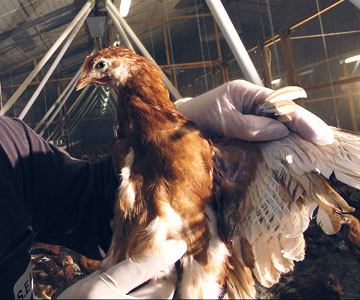M













A new molecular typing technique for the opportunistic mould Aspergillus fumigatus; potential application in hatcheries and poultry farms
S. Thierry (1), (2), D. Wang (1), (3), P. Arné (4), M. Deville (4), B. De Bruin (4), A. Nieguitsila (4), C. Pourcel (5), K. Laroucau (2), R. Chermette (4), F. Botterel (6), J. Guillot (4)
(1) ANSES, UMR BIPAR, Ecopham, Maisons-Alfort, France
(2) ANSES, Bacterial Zoonoses Unit, Maisons-Alfort, France
(3) Parasitology Department, College of Animal Science and Technology, University of Guangxi, Nanning, China
(4) ENVA, UMR BIPAR, Ecopham, Maisons-Alfort, France
(5) Institut de Génétique et de Microbiologie, Université Paris-Sud 11, Orsay, France
(6) UPEC, UMR BIPAR, Ecopham, Créteil, France
S. Thierry, D. Wang, P. Arné, M. Deville, B. De Bruin, A. Nieguitsila, C. Pourcel, K. Laroucau, R. Chermette, F. Botterel, J. Guillot (2012). A new molecular typing technique for the opportunistic mould Aspergillus fumigatus; potential application in hatcheries and poultry farms, EuroReference, No. 6, ER06-12R01.
http://www.ansespro.fr/euroreference/numero6/PN50I0.htm
Aspergillus fumigatus is a ubiquitous mould that usually develops on decaying plant material and in soil. It produces a large quantity of asexual spores, or conidia, which are then released into the air. Human and animal populations are constantly exposed to Aspergillus conidia, but the immune defences of the respiratory system are usually sufficient to destroy the spores before they germinate. In patients with a significant cellular immunity deficit, A. fumigatus can cause a dangerous infection; invasive aspergillosis. Neutropaenia (or functional abnormalities affecting neutrophils and macrophages) remains the main risk factor. Birds, especially poultry such as turkey, are very susceptible to infection by A. fumigatus. Even if the precise economic impact of aspergillosis in avian breeding is unknown, this type of respiratory infection is the cause of production losses due to lower rates of growth, mortality, and slaughterhouse seizures for health reasons (Arne et al., 2011). To implement control measures relevant to farming or hospitals, it is of utmost importance to have tools for understanding the circulation of A. fumigatus mould in animal and human populations and their environment.
The MLVA method is based on the detection of short sequences on the genome called variable-number tandem-repeats (VNTRs) (Figure 1) (Vergnaud et al., 2000). This technique has already been developed for many bacteria, and for the yeast Candida glabrata (Laroucau et al. 2008; Grenouillet et al., 2007). The method has proven to be very discriminating, and in some cases has allowed the isolates to be grouped according to their geographical origin.
The objective of this study was to develop a new molecular typing method based on the detection of VNTR for the mould A. fumigatus. All VNTRs present in the genome of the Af293 strain were analysed, and a final panel of 10 markers was selected. This panel was then tested on a large number of isolates from poultry farms in France and China.
Materials and Methods
Origin of the isolates
In order to test and select discriminating markers, a sample of 57 isolates of Aspergillus fumigatus, geographically and chronologically independent, was selected. It included 53 isolates obtained from organ specimens or pharyngeal swabs from animals (mainly birds) from France and China, three isolates from patients at the university hospital Henri-Mondor (Créteil, France), and the reference strain CBS 144-89.
Subsequently, a second group of 277 isolates was tested with the method. These isolates represented five different epidemiological situations: two duck-fattening farms located in the French region of Sarthe, a chicken farm and a duck farm located in Guangxi province in China, and a turkey hatchery located in the region of Maine-et-Loire in France.
Molecular typing
Molecular typing of isolates was performed by PCR amplification of VNTR markers. Subsequently, the size of the sequences was determined by conventional electrophoresis. From these data, the number of repetitions present was determined for each VNTR.
Bioinformatics analysis
The results were synthesised in the form of a numerical sequence representing the number of repeats for each VNTR obtained, and for each isolate tested. MLVA profiles thus generated were analysed using BioNumerics® software. The profiles were compared by the UPGMA method (Unweighted Pair Group Method with Arithmetic Mean), then expressed as a graph algorithm known as the Minimum Spanning Tree (MST).
Results
Selection of VNTR markers
The Tandem Repeats Finder program (Benson, 1999) identified 77 potential markers distributed among the eight chromosomes that form the A. fumigatus genome. These 77 markers were tested on the first group of 57 independent isolates; a VNTR selection was performed on the basis of the size of the markers allowing good detection by conventional electrophoresis, their ability to produce a usable result (effective amplification) and their ability to highlight different profiles depending on the isolates tested (polymorphism). This selection allowed us to retain a final panel of ten markers, distributed among four of the eight chromosomes of the fungus (1, 5, 6 and 8).
Bioinformatics analysis
The panel of ten VNTR markers was tested on 330 isolates. The analysis identified 255 different MLVA profiles. Only 33 genotypes were shared by two or more isolates. Comparison of genotypes by UPGMA and their representation by MST identified three main groups (Figure 2). The first group includes 91 of the 95 avian isolates (95%) from two duck farms in the Sarthe, France. The second group includes 42 of the 62 avian isolates (70%) from farms in the province of Guangxi in China. Finally, the last group includes 90 of the 120 environmental isolates (75%) collected in the turkey hatchery in Maine-et-Loire, France.
Discriminating power
The discriminating power of the method was determined by calculating Simpson's diversity index (Hunter and Gaston, 1988). The index ranges from 0 to 1 (the value 1 indicates that the method is able to differentiate all isolates tested). The index calculated from the sample tested by MLVA was equal to 0.9994, making it one of the most discriminating methods currently described for the A. fumigatus mould.
Database
To facilitate the transfer of the method to other laboratories, an internet database was created. This database allows comparison of VNTR profiles with more than 300 profiles already referenced.
Discussion
Typing isolates of A. fumigatus is expected to improve understanding of the distribution and circulation of this pathogen in certain environments, such as poultry farming. This molecular approach may also allow a better understanding of host contamination and infection.
Many molecular typing methods have been proposed for the opportunistic pathogen A. fumigatus. The analysis of microsatellite polymorphism remains the most widely used method in epidemiological studies in hospitals. It has a very high discriminatory power (De Valk et al., 2008). One study has also shown the ability of this technique to group genotypes according to their origin (Balajee et al., 2008). CSP-typing is a more recently described method which, although less discriminating than microsatellites, was found to be capable of grouping genotypes based on their epidemiological origin (Balajee et al., 2007). This method is based on the detection of a tandem repeat on the gene of a cell surface protein. However, unlike MLVA, the exact sequence of each repeat is systematically determined. An allele number is assigned to each unique sequence of repeats, and the genotype is then defined by a sequence of alleles of different composition and number.
The MLVA technique, tested here on 330 isolates of A. fumigatus, was very discriminating, rapid, and easy to implement. This method has also demonstrated excellent stability and reproducibility (Thierry et al., 2010). Standardisation and “automation” of the method could be considered in the future by developing a multiplexed capillary electrophoresis system, as well as by developing an internal size marker for each VNTR. This would allow for better exchangeability of the method between laboratories, further improving the reproducibility and ease of implementation.
The main advantage of the MLVA technique remains its ease of use. Migration of PCR products is done on an agarose gel, and the results obtained can be easily compared with those corresponding to other isolates examined in other laboratories.
Research
A new molecular typing technique for the opportunistic mould Aspergillus fumigatus; potential application in hatcheries and poultry farms


References
Arné P, Thierry S, Wang D, Deville M, Le Loc'h G, Desoutter A, Féménia F, Nieguitsila A, Huang W, Chermette R, Guillot J. 2011. Aspergillus fumigatus in poultry. International Journal of Microbiology. 2011;2011:746356. Epub 2011 Jun 14.
Balajee SA, de Valk HA, Lasker BA, Meis JF, Klaassen CH. 2008. Utility of a microsatellite assay for identifying clonally related outbreak isolates of Aspergillus fumigatus. Journal of Microbiological Methods 73:252-256.
Balajee, SA, Tay ST, Lasker BA, Hurst SF, Rooney AP. 2007. Characterization of a novel gene for strain typing reveals substructuring of Aspergillus fumigatus across North America. Eukaryot Cell 6:1392-1399.
Benson G. 1999. Tandem repeats finder: a program to analyze DNA sequences. Nucleic Acids Research, 27(2):573-580.
de Valk HA, Klaassen CH, Meis JF. 2008. Molecular typing of Aspergillus species. Mycoses 51:463-476.
Grenouillet F, Millon L, Bart JM, Roussel S, Biot I, Didier E, Ong AS, Piarroux R. 2007. Multiple-locus variable-number tandem-repeat analysis for rapid typing of Candida glabrata. Journal of Clinical Microbiology, 45(11):3781-3784.
Hunter PR, Gaston MA. 1988. Numerical index of the discriminatory ability of typing systems: an application of Simpson's index of diversity. Journal of Clinical Microbiology, 26(11):2465-2466.
Laroucau K, Thierry S, Vorimore F, Blanco K, Kaleta E, Hoop R, Magnino S, Vanrompay D, Sachse K, Myers GS, Bavoil PM, Vergnaud G, Pourcel C. 2008. High resolution typing of Chlamydophila psittaci by multilocus VNTR analysis (MLVA). Infection, Genetics and Evolution, 8(2):171-181.
Thierry S, Wang D, Arne P, Deville M, De Bruin B, Nieguitsila A, Pourcel C, Laroucau K, Chermette R, Huang W, Botterel F, Guillot J. 2010. Multiple-locus variable-number tandem repeat analysis for molecular typing of Aspergillus fumigatus. BMC Microbiology 10:315.
Vergnaud G, Denoeud F. 2000. Minisatellites: mutability and genome architecture. Genome Research, 10(7):899-907.
Figure 1. Principle of Multiple Locus VNTR Analysis
Figure 2. Minimum spanning tree representing 330 isolates tested, using 10 VNTR markers. Each circle represents a unique genotype. The diameter of the circle is proportional to the number of isolates sharing the genotype. The genotypes are connected by a straight line, representing the number of differences between them. A thick solid line indicates one difference between genotypes, while a thin solid line indicates two, a thick dotted line represents three differences, and finally a thin dotted line represents four or more differences. The genotypes are also linked by a coloured background representing groups of isolates separated by two or fewer differences. The length of the branches is also proportional to the number of differences. Each epidemiological situation is represented by a specific colour: red for isolates collected at the first duck farm in the Sarthe region (France) in 2007 and 2008, pink for isolates collected at the second duck farm in the Sarthe region (France) in 2007 and 2008, dark blue for isolates collected at the chicken farm in Guangxi province in China in 2008, light blue for isolates collected at the duck farm in Guangxi province in China in 2008, green for environmental isolates collected in 2009 at the turkey hatchery at Maine-et-Loire (France), and finally yellow for the group of independent isolates, consisting of 57 geographically and chronologically independent isolates of Aspergillus fumigatus, including 53 avian isolates, three human isolates, and the reference strain CBS 144-89.
The MLVA (Multiple-locus variable-number tandem repeat analysis) molecular typing method has proven to be very useful for the genotyping of many microorganisms, providing much information, especially in the context of epidemiological studies.
In this study, we developed this technique for the filamentous fungus Aspergillus fumigatus. The method was tested on a panel of isolates of avian origin collected from French and Chinese farms.
The method proved to be very discriminating, fast, and easy to use. Furthermore, it also demonstrated an ability to group genotypes according to the geographical origin of isolates. Thus, this method is an important epidemiological tool in the study of the circulation of this pathogen in farms.





